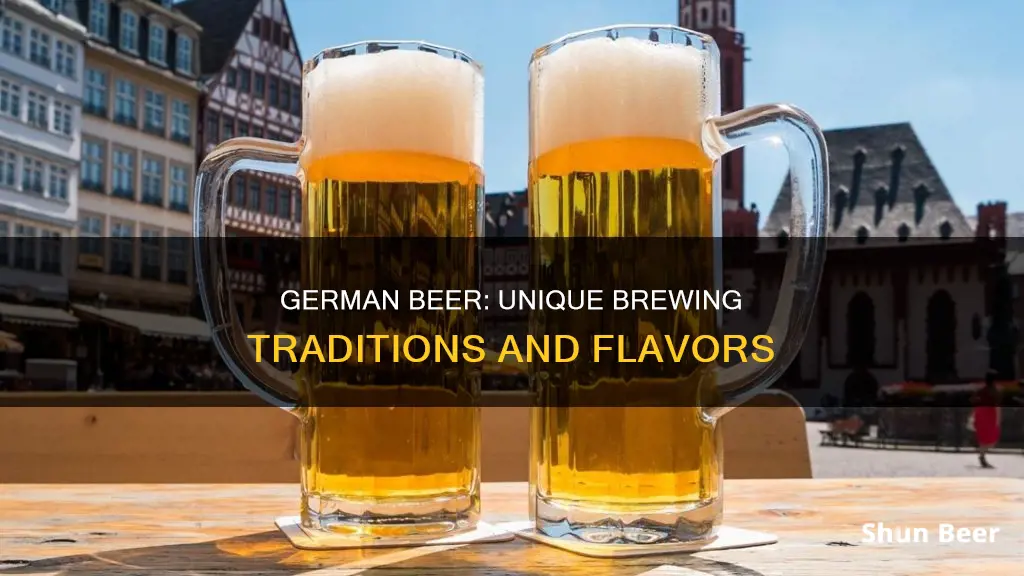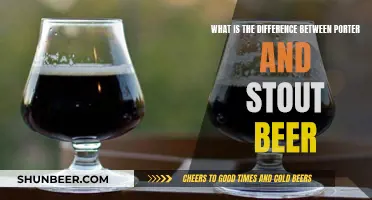
German beer is a topic as deep and complex as the brews themselves. With over 1,300 breweries producing more than 5,000 types of beer, Germany is a Bierland (beer country).
The country's long history of beer-making stretches back to the end of the year 1000 AD, when monasteries began brewing beer for public consumption. The oldest brewery still in operation in the world is Weihenstephan, founded in 1040.
The German Beer Purity Law (or Deutsches Reinheitsgebot) has governed beer-making in the country since 1516, when it was introduced by Duke William IV of Bavaria. The law states that only barley, malt, hops, and water are permitted as ingredients in the beer-making process.
German beers can be broadly categorized into lagers and ales. Lagers include the ubiquitous pilsner, as well as helles, export lager, and märzen/Oktoberfestbier. Ales include wheat ales like hefeweizen, and altbier, a specialty from Düsseldorf.
Each region in Germany has its own particular type of beer and brands, which vary according to local ingredients and brewing traditions. So, the next time you raise a glass, remember the German Beer Purity Law, the diverse styles, and the spirited celebrations of Oktoberfest.
What You'll Learn

German beer purity laws
The German Beer Purity Law, also known as the Reinheitsgebot, is a series of regulations that limit the ingredients in beer in Germany and the states of the former Holy Roman Empire. The law was first enacted in 1516 by Duke Wilhelm IV of Bavaria and is one of the oldest food and beverage regulations in the world that is still in effect, although with some modifications.
The original law limited the ingredients in beer to just barley, hops, and water. The role of yeast in the fermentation process was not yet discovered, so it was not included in the original law. However, yeast was later added to the list of permitted ingredients after its role in fermentation was understood.
The main purposes of the law were to protect beer consumers from poor-quality and potentially lethal beverages, to ban the use of wheat in beer brewing to ensure bread production was not affected, and to prevent unscrupulous brewers from adding dubious and toxic ingredients as preservatives or flavourings.
Today, the German Beer Purity Law states that only malted grains, hops, water, and yeast may be used in the production of beer. The law has been modified over the years to accommodate the use of other ingredients, such as wheat and certain types of malted grains. However, the core principle of using only natural ingredients remains, and artificial additives are not permitted.
The German Beer Purity Law is considered a valuable part of Germany's cultural identity, with a recent survey showing that up to 85% of the population support the law. It has also contributed to the country's reputation for high-quality beer, with Germany exporting approximately 1.5 billion litres of beer annually.
However, the law is not without its critics. Some German brewers argue that the restrictions lead to uniformity and encourage large-scale production rather than innovation. They claim that the law removes their creative licence and results in a market of very similar beers. There is also a debate about whether the law truly protects consumers from harmful ingredients or if it is primarily a protectionist measure to maximise profits and keep out competitors.
Pale Beer: What Sets It Apart?
You may want to see also

German drinking culture
Drinking culture in Germany is vastly different from that of the United States. While alcohol in the US is often treated as a taboo, with a legal drinking age of 21, drinking in Germany is more casual. Beer and wine are part of a normal dinner in Germany, and alcoholic drinks are usually offered to guests. However, not drinking is completely accepted, and it is important to respect someone's decision if they choose not to drink. The legal drinking age in Germany is 16 for beer and wine, and 18 for spirits.
Germany has a rich history of beer drinking, with thousands of beer varieties available in the country. Beer is easily accessible all over Germany, but this access is regulated by strict rules. Minors are not allowed to buy or drink alcohol in public places unless they are with an adult. Customer IDs must be checked when purchasing alcohol, and alcohol can only be purchased from Monday to Saturday from 6 am to 10 pm. It cannot be purchased on Sundays or public holidays.
When drinking beer in Germany, there are certain traditions and rituals to follow. For example, when clinking glasses or making a toast, it is considered bad luck to cross your arms with the people you are drinking with. It is also important to make eye contact with the person you are toasting with. Another tradition is to use the proper glassware for different types of beer. For example, Weizenbier, Weißbeer, or Hefeweizen should be drunk from a Weizenbier high glass, which is narrow at the bottom and wide at the top, allowing the yeast to spread and improve the taste.
Beer is also an important part of German festivals and celebrations, such as Oktoberfest, a 16- to 18-day festival held annually in Munich, Bavaria. Large quantities of German beer are consumed during this festival, with almost 7 million liters served during the 16-day festival in 2007.
Explore the Diverse World of IPA Beers
You may want to see also

German beer festivals
Beer is a major part of German culture, and Germany has several beer festivals throughout the year. Here are some of the most notable ones:
Oktoberfest, Munich
Oktoberfest is the world's largest Volksfest (folk festival), featuring a beer festival and a travelling carnival. It is held annually in Munich, Bavaria, from mid- or late September to the first Sunday in October. The festival attracts more than six million international and national visitors, who consume large quantities of Oktoberfest Beer, enjoy amusement rides, side stalls, games, and traditional foods. The festival originated in 1810 when citizens of Munich were invited to attend festivities held on the fields in front of the city gates to celebrate the marriage of Crown Prince Kronprinz Ludwig and Princess Therese of Saxe-Hildburghausen. The fields were named "Theresienwiese" ("Theresa's Meadow") in honour of the Crown Princess and have kept that name ever since, although locals have abbreviated it to Wiesn.
Starkbierfest, Munich
Starkbierfest, also known as the Strong Beer Festival, takes place each spring in Munich and focuses on the drinking of strong beers, such as bocks and dopplebocks, with alcohol percentages of 7% ABV and above. The festival is held at the Paulaner Nockherberg and various other locations around Munich, attracting thousands of visitors each year. It features the same delicious German food, sexy outfits, and revelry as Oktoberfest, but with a greater emphasis on strong beers.
Springfest, Munich
Springfest, known locally as Frühlingsfest, is another beer festival held in Munich. It takes place in the spring, just a month after Starkbierfest, and is similar to Oktoberfest in that it features big tents, rides, and delicious beers, all on the Theresienwiese, the same spot as Oktoberfest. However, Springfest offers just two large tents, making it a more intimate version of its bigger cousin.
Stuttgart Beer Festival
The Stuttgart Beer Festival, known in German as Cannstatter Volksfest, is the second-largest beer festival in the world, after Oktoberfest. It takes place over 17 days in September and October in Stuttgart, the birthplace of Porsche and Mercedes. The festival incorporates rides, markets, huge beer tents, litre-sized beers, live entertainment, and a crazy party atmosphere. It is said to be less rigid and more local than Oktoberfest, making it a favourite among beer enthusiasts.
Stuttgart Spring Festival
Like its autumnal counterpart, the Stuttgart Spring Festival (known locally as Stuttgarter Frühlingsfest) is bigger than Munich's Springfest, featuring five huge beer tents and an extra week of shenanigans. It takes place in the spring, helping revellers thaw out after the long winter.
In addition to these major festivals, there are several other German beer festivals throughout the year, including the Berlin Beer Festival in August, Bergkirchweih in Erlangen in May-June, Freimarkt in Bremen in October-November, Hamburger Dom in Hamburg, Gäubodenvolksfest in Straubing in August, and Bierfest in Kulmbacher in July-August.
Beer and Cider: Exploring Their Diverse Classifications and Varieties
You may want to see also

German beer history
German beer has a long and fascinating history, dating back to the 10th century when brewing was considered a woman's responsibility. Using a mixture of herbs called gruit, women from different families would often share a space for brewing. However, it was the monks in the monasteries who really perfected the art of beer-making, with German monasteries producing beer for mass consumption since around the year 1000. Located predominantly in Southern Germany, some of these monasteries, such as Kloster Andechs, St. Gallen, and Weltenburg, still exist today.
In the 12th and 13th centuries, hundreds of monasteries were researching and refining the craft of brewing, and monks eventually started to sell their beer. It was during this time that the first wheat beer or Weissbier was brewed in Bohemia. The style then spread to Bavaria, where, in 1520, the Degenberg family obtained exclusive rights to brew wheat beer.
Then, in 1516, an important event occurred that shaped the future of German beer. The Duke of Bavaria signed the Reinheitsgebot, or Beer Purity Law, which decreed that only three ingredients could be used to brew pure beer: water, barley malt, and hops. This law was intended to ensure quality beer and reasonable prices, while also protecting the wheat needed for bread-making. Yeast was later added as a fourth allowed ingredient once scientists discovered its role in the fermentation process.
The Beer Purity Law had a significant impact on the types of beer produced in Germany and is still considered a badge of honour by many German brewers. It led to the development of new lager styles, such as Marzen, Dunkel, Rauchbier, and Schwarzbier. These beers were brewed during specific months and stored in underground cellars, giving rise to the traditional German Biergarten or beer garden.
Over the centuries, German beer has continued to evolve, with new styles such as Helles and Pilsner gaining popularity. Today, Germany boasts over 1,300 breweries, producing more than 5,000 different types of beer. German beer culture is celebrated worldwide through festivals such as Oktoberfest, where millions of litres of beer are consumed each year.
Lager vs Strong Beer: Understanding the Alcohol Content Difference
You may want to see also

German beer brands
German beer is a major part of the country's culture. In fact, Germany ranks third in Europe for per-capita beer consumption. With over 1,500 breweries, it's no surprise that Germany produces 5,000 brands of beer.
Bitburger
Bitburger was founded in 1817 in Bitburg, Rhineland-Palatinate. The brand's staple drink is the Bitburger Premium Pils, an unfiltered lager. They also offer an alcohol-free version called Bitburger Drive 0.0%. Bitburger is one of the dominant brands in the German beer market, ranking as the third best-selling beer in the country and the nation's leading draft beer.
Köstritzer
Köstritzer is one of Germany's oldest Schwarzbier (black beer) producers, with a history dating back to 1543. The Köstritzer Schwarzbier is a dark beer known for its distinctive roasted malt character. In addition to their Schwarzbier, Köstritzer offers a range of other beers, including a pale lager, a wheat beer, and a cola-beer mix.
Erdinger
Erdinger Weißbräu Werner Brombach GmbH, founded in 1886, is the world's largest wheat beer brewery. Erdinger offers a diverse range of wheat beers, including their crowd favourite, the Weißbier, a golden, cloudy delight with a 5.3% ABV. They also have a non-alcoholic option, the Alkoholfrei, with an ultra-low ABV of 0.4%.
Beck's
Beck's Brewery, founded in 1873 in Bremen, is known for its iconic green bottle. Their superstar is the Beck's Pilsner, a classic German-style pilsner with a 5% ABV. Beck's also offers a range of other beers, including Beck's Gold, a premium beer with a blend of hops and barley malt, and Beck's Blue, a crisp and clean non-alcoholic option.
Krombacher
Krombacher, established in 1803, is a well-established German beer label. Their flagship offering is the Krombacher Pilsner, a classic German-style pilsner with a 4.8% ABV. Krombacher also offers a dark lager, the Krombacher Dark, and a wheat beer, the Krombacher Weizen. The brand is committed to sustainability and environmental preservation.
IPA vs APA Beer: What's the Difference?
You may want to see also
Frequently asked questions
German beer is traditionally brewed with only four ingredients: barley, malt, hops, and water.
The German Beer Purity Law, or Deutsches Reinheitsgebot, was passed in 1516 by Duke William IV of Bavaria. It states that only the four traditional ingredients (barley, malt, hops, and water) are allowed in the beer-making process.
Some popular German beer styles include Pilsner, Helles, Bock, Doppelbock, Oktoberfest/Märzen, Dunkel, Hefeweizen, Kölsch, and Berliner Weisse.
German-style Pilsner tends to be lighter in body and color, drier, and more bitter than its Czech counterpart.
Germans have a more relaxed attitude towards drinking beer, with a legal drinking age of 16 for "soft" alcoholic beverages. Drinking in public is common and accepted in many parts of the country.







